

 JOHN CHANDLER looks back at the history of the French high-speed train.
JOHN CHANDLER looks back at the history of the French high-speed train.
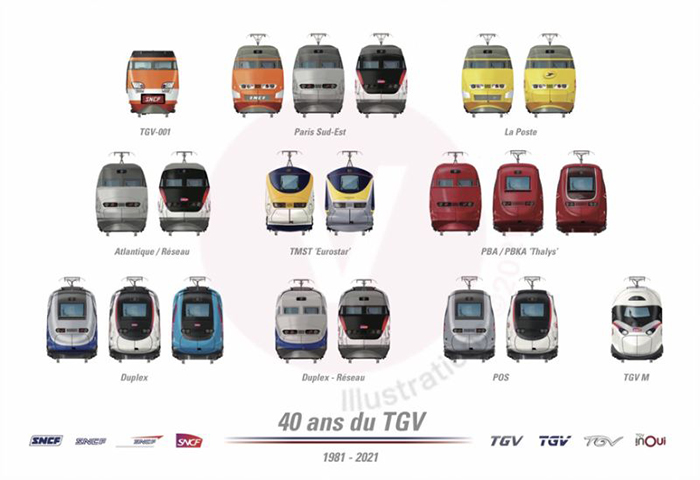
On 27th September, 1981, a new train departed Paris Gare de Lyon on its inaugural service bound for the city of Lyon. The astute amongst you will have noticed that this happened just over forty years ago! During this time, several developments and innovations have enhanced the TGV fleet resulting in some 22 variations on a theme. However, development started some 15 years earlier, spurred on by an attempt to increase the traffic between Paris and Marseilles. The result is a network of dedicated High Speed Lines (LGV, Lignes à Grande Vitesse) criss-crossing France with links into Germany, Belgium, Holland, Switzerland, Italy, Spain, and, yes, even England (HS1 to St Pancras)! Normal running speed was initially 270kmh (about 170mph) but over the years, this has crept up to 320kmh (200mph) and is still rising.
Throughout the forty years, there has arisen another incentive to increase the high speed network based on the need to reduce fuel emissions. To this end, the check-in desk for Air France flights from Bruxelles to Paris was at Bruxelles Midi (Zuid) station; you’re going by train! As a general rule of thumb, it is reckoned that, taking into account the check-in times, security requirements, luggage collection and travel to and from the respective city centres, it is easier to go by train centre-to-centre than by air for journeys of 4 hours or less.
Development of the TGV (Train à Grande Vitesse) started back in the late 60s when fuel was abundant and the original approach was based on the idea of gas turbines driving alternators to generate electricity to power the traction motors on most axles of the train. SNCF (French National Railways) had already developed the RTG (Rame turbine à gaz) and wanted to expand on the technology. The original prototype power car, TGV-001 can be seen plinthed at Bischheim just outside Strasbourg.
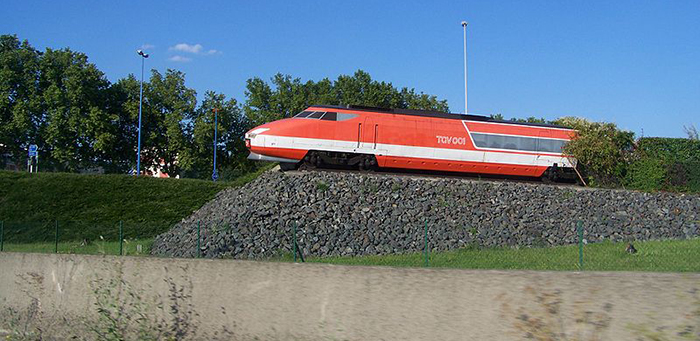
It was soon realised that this was not the way to go and development diverted to overhead electric power based on 25KV at 50Hz. This still remains generally the case.
The French had gained much experience in raising the speed of trains with several runs on the Paris – Beaune line using monitoring equipment to watch the behaviour of the catenary and the pantograph as the speed of the locomotive increased. It was realised that the nature of the track was a restricting factor, as were the signalling system and the catenary. (On some speed runs, the catenary was destroyed!)
The LGV was born. Designed with large radius curves and in-cab signalling, speeds in excess of 300kmh (187mph) became possible.
In another innovation, the TGV was designed as an articulated set, i.e. adjacent passenger coaches shared a common Jacobs-style bogie. This had the added advantage that coaches could be ‘coupled’ at various points around their frame, making the set more rigid, stable and comfortable. Due to this design, it is interesting to note that, with one notable exception, every TGV which has been involved in an accident has remained upright and in-line.
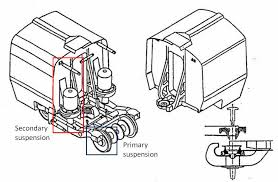
The Eschede derailment in Germany brings this point home for me; the ICE suffered a wheel failure causing it to hit a bridge parapet. As the coaches were not articulated, the train concertinaed.
It is interesting to note that when Amtrak wanted to introduce the concept of High Speed trains into the USA, the concept of articulated bogies was not acceptable and the coaches had to have two distinct bogies. This further meant that the ends of the coaches had to be reinforced with crumple zones to withstand impact and increased the weight of the coaches significantly whilst also reducing their maximum speed.
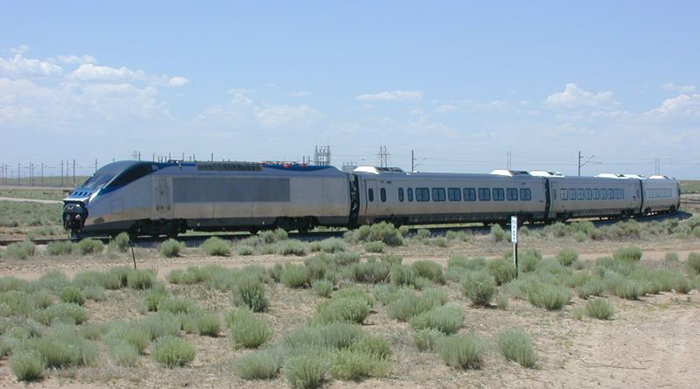
Acela high-speed train testing at the Transportation Technology Center in Colorado, USA.
The TGV-PSE (Paris Sud Est) began passenger service in September 1981 with an operating speed of 270kmh (170mph), reducing the journey time to around 2 hours city centre to city centre over LGV 1.
The rest, as they say, is history and there are now commitments to LGVs linking Bordeaux – Toulouse, Marseilles – Nice and Montpellier – Perpignan, as announced by French President Emmanuel Macron earlier this month as part of the Anniversary celebrations.
The Orange-liveried TGV-PSE was the original series with two power cars and eight articulated passenger coaches in between and has formed the basis of many other styles of TGV. With some notable exceptions, the TGV formation between the power cars has always been:
R1 (R11): First Class Accommodation
R2 (R12): First Class Accommodation
R3 (R13): First Class Accommodation
R4 (R14): Bar Buffet
R5 (R15): Second Class Accommodation
R6 (R16): Second Class Accommodation
R7 (R17): Second Class Accommodation
R8 (R18): Second Class Accommodation
Note that R11 thru’ R18 indicate that at some stage in its journey, it will be art of a two unit set.
Services such as the Thalys (PBA and PBKA*), Lyria, Duplex and POS all follow this system.
*P = Paris, B = Bruxelles, K = Köln (Cologne), A = Amsterdam
More recently, economy versions of the TGV service have been developed, such as the Ouigo, a single class train with no buffet but plenty of affordable seats available with near instant on-line booking.
I mentioned some notable exceptions.
The most obvious one is the TGV Atlantique. This had ten passenger coaches rather than the usual eight with an extra First (say, R2½) and Second (say, R6½) car added to the relevant sections.
Less obvious is the Series e300 Eurostar. Due to the regulations imposed on Channel Tunnel passenger traffic, it had to be possible to transfer from one part of the train to the other. With two conventional TGV sets joined, this would be impossible so the two intermediate motor cars were replaced with two passenger cars in the following formation:
M1 (M2): Power Car
R1 (R18): Second Class Accommodation
R2 (R17): Second Cass Accommodation
R3 (R16): Second Class Accommodation
R4 (R15): Second Class Accommodation
R5 (R14): Second Class Accommodation
R6 (R13): Bar Buffet
R7 (R12): First Class Accommodation
R8 (R11): First Class Accommodation
R9 (R10): First Class Accommodation (Would have been power cars)
Unlike the ‘normal’ TGV, which uses screw couplings between the power cars and the passenger coaches (M1–R1, R8-M2), the Eurostar e300 uses Scharfenberg couplings between M1-R1, R9-R10 and R18–M2 which can be remotely operated from either power car to detach part of the train in case of emergency.
The basic TGV-PSE has been adapted into an experimental tilting version (TGV-P) and a ‘fleet’ of 2½ sets of dedicated TGV-Poste units modified to have their loading doors at platform height and nearer the middle of the coach so that several cages of post (Yorks) could be loaded quickly and easily.
The most noted variant of the TGV (Project V150) was that used for the World Speed Record attempt which culminated on April 3rd, 2007. 574.8kph (357.2mph) was attained on a stretch of the (as yet unopened) LGV EST between Paris and Strasbourg using a five-car set, 4402. Two power cars and three passenger coaches fitted out with the necessary monitoring equipment ran ‘wrong line’ (all LGVs are ‘signalled’ for bidirectional working) on a downhill grade from Strasbourg towards Paris under a modified catenary voltage of 31kV with one coach fitted with the experimental AGV* motor system.
*AGV – Automatrice à Grand Vitesse, a design, now used on some lines in Italy, which does away with the two power cars and distributes the traction throughout the unit.
The two power cars used in setting this record are still in use today with TGV Lyria, a Paris – Switzerland operation and retaining the set number of 4402, seen here on the right.
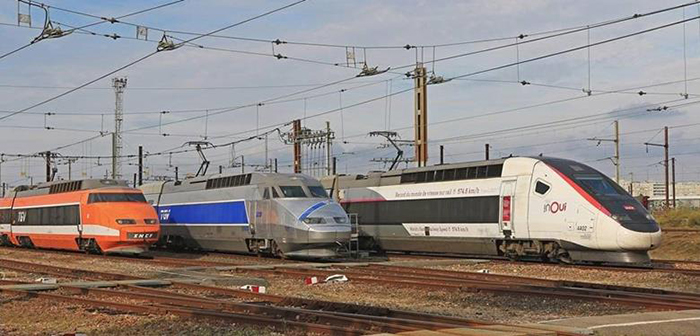
So, what of the future?
We have already seen 4 generations of TGV:
1. The original Paris – Sud Est sets which morphed into various guises restricted to 270kmh (about 170mph).
2. The TGV Atlantique with its higher speed up to 300kph (187mph) and with two additional passenger cars.
3. The TGV Duplex; reverting to the original 8+2 configuration but with 320kmh (200mph) operating speed and with two decks.
4. The AGV; fantastic idea to distribute the traction amongst all cars rather than just M1 and M2, but suffered limitations (amongst which include that it could only be single decked). Only 25 sets were built and all sold to Italy.
Generation 5 sees the TGV-M (M for Modular).
This solves many of the problems encountered with the AVG and allows two decks whilst retaining power distribution through the set.
It also allows for extra passenger cars to be added, a feature which had not previously been possible.
This video explains the development of the TGV and the improvements offered by the TGV-M concept.
